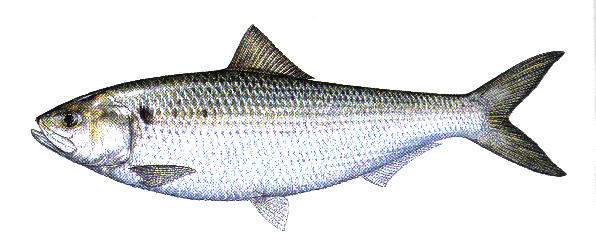
Ultrasonic Hearing by Clupeid Fishes
Clupeid fishes (herrings and shads) are among the main prey of echolocating cetaceans, such as the harbour porpoise (Phocoena phocoena) and bottlenose dolphin (Tursiops truncatus). The echolocation clicks of cetaceans are high frequency (80-120 kHz), high intensity (180-220 dB re 1mPa, peak-to-peak source level) sounds that reflect off objects in the marine environment, such as fishes. Researchers studying the distribution of blueback herring observed that they swam away from echosounders used to quantify fish abundance, suggesting that clupeids may be able to detect ultrasound.
Several years ago we determined the hearing thresholds of a clupeid, the American shad (Alosa sapidissima), from 0.2 to 180 kHz, and found they could indeed detect ultrasound (see figure on right) (Nature, 1997, 389:341; J. Acoust. Soc. Am., 104:562-568) (Figure above) We found that American shad have best sensitivity from 0.2 to 0.8 kHz in the sonic range and from 25 to 130 kHz in the ultrasonic range. American shad were also able to detect simulated bottlenose dolphin (Tursiops truncatus) echolocation clicks with a threshold that suggests they could detect an echolocating dolphin at distances up to 187 m. The evolution of a mechanism to detect predator ultrasound in fishes may parallel the evolution of a mechanism by moths to detect their bat predators.
Auditory thresholds were determined for American shad using a classical conditioning paradigm where fish learned to reduce heart rate whenever they heard a sound. Once the fish learned the task, the parameters of the sound was changed in frequency and intensity and the lowest detectable sound was considered to be the threshold. Shad could detect sound from 200 Hz to over 180,000 Hz (below, figure on left).
Hearing thresholds for shad may be compared to data for other fishes. In particular, goldfish (Carassius auratus) is a 'hearing specialist' and can only detect sounds to about 3,000 Hz. In contrast, the bottlenosed dolpin,Tursiops truncatus, is able to detect sounds to above 150,000 Hz, and its echolocation signal can be varied over most of the ultrasonic detection range of shad (red rectangle in figure on right below).
We have also used used Auditory Brainstem Responses (ABR) to measure hearing capabilities of several other clupeid species in order to ascertain whether ultrasonic hearing is found in all Clupeiformes, or whether it is only found in a limited number of species. Results (figure above) show that only species related to the genus Alosa, including American shad and gulf menhaden, detect ultrasound, while other species, such as the Spanish sardine and bay anchovy are only able to detect sounds to about 4 kHz (figure to right).
An overview of ultrasound detection can be found in Popper (2000) and in the following research papers.
Mann, D.A., Lu, Z., and Popper, A.N. (1997) Ultrasound detection by a teleost fish. Nature 389:341.
Mann, D. A., Lu, Z., Hastings, M. C. and Popper, A. N. (1998). Detection of ultrasonic tones and simulated dolphin echolocation clicks by a teleost fish, the American shad (Alosa sapidissima). J. Acoust. Soc. Am., 104:562-568.
Mann, D. A., Higgs, D. M., Tavolga, W. N., Souza, M. J., and Popper, A. N. (2001). Ultrasound detection by clupeiform fishes. J. Acoust. Soc. Am. 109:3048-3054.
Mann, D. A., Higgs, D. M., Tavolga, W. N., and Popper, A. N. (2002). Ultrasound detection by clupeiforme fishes. Bioacoustics, 12:188-191.
Mann, D. A, Popper, A. N. and Wilson, B. (2005). Pacific herring hearing does not include ultrasound. Biology Letters, 22:158-161.
Plachta, D. T. T. and Popper, A. N. (2003). Evasive responses of American shad (Alosa sapidissima) to ultrasonic stimuli. Acoustics Research Letters Online (ARLO), 4:25-30. doi:10.1121/1.1558376
Plachta, D.T.T., Song, J., Halvorsen, M.B., and Popper, A.N. (2004). Neuronal encoding of ultrasonic sound by a fish. J. Neurophysiol., 91:2590-2597. Doi:10.1152/jn.01200.2003.
Popper, A.N., Plachta, D.T.T., Mann, D.A., and Higgs, D. (2004). The response of clupeid fishes to ultrasound: a review. ICES J. Mar. Sci., 61:1057-1061.

